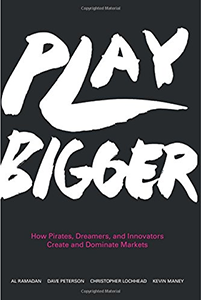
The CMO’s of Tomorrow Will Be Category Designers
By Al Ramadan, Dave Peterson, Christopher Lochhead, and Kevin Maney
History shows us that the great category creators of the past few decades in the technology industry have been CEO’s. Brian Chesky from AirBnb turned his insight of renting air mattresses for beer money into a new multi-billion dollar hospitality category. Travis Kalanick from Uber turned his frustration for hailing smelly taxis to a new category that is shaking the foundation of the entire transportation sector. And of course, legends like Steve Jobs, Marc Benioff, and Jeff Bezos created new categories from their sheer will and genius to dominate the computing, cloud, and retail industries.
It’s not hard to understand why many think that category creation does not belong in the world of the CMO. Just ask yourself who were the CMOs behind the categories listed above? There’s a reason why that is hard to answer, because until now, category creation has lived in the realm of the founder and CEO. That’s about the change, but to understand why, you have to learn a bit more about category creation.
We have studied thousands of companies and interviewed hundreds of these great leaders. We have figured out that the great companies give us new ways of living and thinking, many times solving a problem we didn’t know we had. These companies don’t make ‘better’ products or services that just incrementally improve on whatever came before. They sell us a different answer that sits in a container called a category. These new and different categories make what came before seem outdated, clunky, inefficient, costly or painful.
These creations all start with the founder’s insight, according to Ann Mira-Ko at Floodgate. It could be a technology insight that leads to an invention of a powerful new solution to an unsolvable problem. Often, the founding insight is so powerful that it hatches a new product and eventually a company backed by millions in financing. And, if the CEO is of a certain personality type, a category is created by the evangelism of her vision.
In some cases the CMO and the marketing team are asked to help the CEO create a new category. The assignment from the CEO is crystal clear – “help the world see the category that I see.”
The plan to make this happen is much more opaque, which is why many CMOs shudder with the notion of selling a three letter acronym to a Gartner analyst, or recasting a new brand, or executing category ad campaigns that don’t produce measurable leads (but do produce loud complaints from the sales team). Even if you get all of this stuff right, it’s hard to move the entire organization around a single strategy from the CMO seat. That’s why category creation has not lived in the realm of the CMO. It was too much art in a world dominated by measuring every single signal, action, and motion in marketing.
However, the new discipline of category design is empowering CMOs to partner with the CEO and take the reigns on category creation in a structured and measureable process.
CMOs are using category design to cut through the noise produced by powerful digital marketing engines.

While there is debate about how many marketing messages we experience each day, this NYTimes article the author (and researchers) make the case that at that time we were “dealing” with more than 5,000 marketing messages per day, up from 2,000 a couple of decades before. If those numbers are true then we are probably dealing with 2X that many messages since social and mobile marketing platforms have exploded since then. Category designers use the art of the POV and the science of hard-hitting lightning strikes to cut right through this noise and impact their targets in an un-avoidable way.
CMOs are using category design to condition the minds of their target markets.
For every problem, there are literally dozens, perhaps hundreds of solutions driven by the ubiquity of networks, cheap cloud-based distribution and lightning-fast word-of-mouth through social media. The sheer number of choices makes it almost impossible to figure out which product to buy.
CMO’s know our brains can’t cope with thousands of options every day. When our brains are in this kind of overload state, people make decisions based on instinct not logic. According to leading researchers on brain science four key brain biases switch on to help the brain cope with the volume - such as the anchoring effect, choice supportive bias, groupthink and conformity bias. CMOs are now using category design as a way to control these biases and condition their targets to the right answer.
CMOs are using category design to move from the digital marketing ghetto back to strategic leadership.
CMOs understand that category design is one leg of a three-legged stool – deeply connected to product design and company design. While they understood that category design is the discipline of creating and monetizing new markets they were often frustrated by the fact that it was only the CEO who could be effective at category design because they were the only person who could reach across all the key departments and bring teams together. They understood that like more mature disciplines, such as product design and experience design, category design is a cross-functional discipline. In the end, CMO’s who learn the category design discipline find themselves directing cross-functional initiatives that go far beyond the realm of marketing.
The great news is that discipline of category design is now a defined process and can be learned and easily adopted into marketing. In fact it’s recently been taught at Stanford University Management Science and Engineering School. There is also a rising generation of category designers in the marketing ranks that will soon be taking their first CMO gigs. And we expect a new generation of category design CMOs to take the discipline to a whole new level. One thing we feel certain of is that the CMOs of tomorrow will become the category designers of tomorrow.
-----------
Al Ramadan, Dave Peterson, Christopher Lochhead, and Kevin Maney are the authors of Harper Collins, Play Bigger: How Pirates, Dreamers and Innovators Create and Dominate Markets
REFERENCES for the brain science


